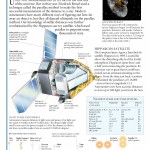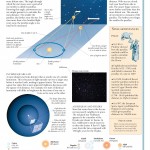Until 1838, Astronomers had little idea of the true size of the Universe. But in that year, Friedrich Bessel used a technique called the parallax method to make the first successful measurement of the distance to a star.
Modern astronomers have many different ways of figuring out how far away an object is, but they all depend ultimately on the parallax method.
As the Earth orbits the Sun, the nearer stars seem to move from side to side against the background of more distant stars. The angle through which the star moves over a period of six months is called its parallax.
Knowing this angle, astronomers can use simple geometry to calculate the star’s distance. The smaller the parallax, the further away the star.
Related posts:
After Pluto was discovered in 1930, it was regarded as the ninth major planet, although it was soon found to be very different from the others. It is smaller than Earth’s Moon and follows an elongated, titled orbit. In the 1990’s astronomers began to discover small bodies similar to Pluto beyond Neptune. Some, such as Eris, were larger then Pluto. In 2006, astronomers decided to define a ne...
Jupiter is the fifth planet from the Sun and the most vast planet in the Sun oriented System. It's a gas monster with mass one-thousandth that of the Sun but is more than two times the mass of every last trace of the different planets in our Earth's planetary group joined together. Jupiter is arranged as a gas monster plus Saturn, Uranus and Neptune. As one, these four planets are at times poi...
When a Metorite collides with Earth it can form an impact crater – a bowl – shaped hollow in the Earth’s surface. Space rocks have produced in this way throughout Earth’s life, especially when the planet was young, about 4 billion years ago. Space rocks do not have to hit Earth to have a devastating effect. On june 30, 1908, there was an explosion 3.5 miles up in Earth’s atmosphere, above...
People have dreamed of exploring the Moon for hundreds of years. The United States and Russia made the dream a reality in the middle of the 20th century. In 1959, Luna 1- the first spacecraft to leave the Earth’s gravity – was launched toward the Moon. A decade of intense space activity followed as Russian and American probes, robots, and crewed craft were sent to investigate and land on the l...
Scratches is presently accommodate to five working shuttle: several in circle—the Scratches Odyssey, Scratches Express, and Scratches Surveillance Orbiter; and two on the surface—Scratches Investigation Wanderer Opening and the Scratches Science Research facility Interest. Old space apparatus on the surface incorporate MER-A Spirit, and a few different idle landers and meanderers, both on trac...
The Assumption of prehistoric cosmic detonation is the overall cosmological model that portrays the early improvement of the Universe. As per the Huge explosion argument, the Universe was once in an extensively sweltering and thick state which developed quickly. This fast development created the Universe to cool and bring about its display persistently developing state. Consistent with the most u...
A star chart or star map is a map of the night sky. Astronomers divide these into grids to use them more easily. They are used to identify and locate astronomical objects such as stars, constellations and galaxies. They have been used for human navigation since time immemorial.
The Solar system comprises of the Sun and its planetary framework of eight planets, their moons, and different non-stellar questions. It shaped roughly 4.6 billion years back from the breakdown of a monster sub-atomic mist. The unfathomable larger part of the framework's mass is in the Sun, with the majority of the remaining mass held in the planets. The four more diminutive internal planets, Merc...
Radio waves are the same type of waves as light. They have less energy than visible light and so have a longer wavelength, but they travel at the same speed as light. At night our eyes and optical telescopes sees light from stars. But normal stars only produce radio waves very weakly.
In the connection of spaceflight, a satellite is an item which has been put into space by human endeavour. Such protests are now and again called simulated satellites to recognize them from instinctive satellites for example the Moon.
Protostar Evolution in detail contains a random amount of interstellar gaseous matter, mainly hydrogen, containing traces of dusts (ices, carbon, rocks).
In its 27 – day Orbit of the Earth, the Moon sometimes passes directly in front of the Sun and we see a solar eclipse. In one of the natural world’s most eerie, beautiful spectacles, the dark circle of the Moon gradually creeps over the Sun. Between two and five solar eclipses are visible from somewhere on the Earth each year. When the Moon is at its farthest from the Earth, it is not ...
Saturn is the sixth planet from the Sun and the second most expansive planet in the Earth's planetary group, following Jupiter. Named following the Roman god Saturn, its galactic image (♄) speaks for the god's sickle. Saturn is a gas mammoth with a middle range something like nine times that of Earth. While one and only one-eighth the mean thickness of Earth, with its more impressive volume Sa...
The Lunar Module basically consists of many electronically connected parts that helps the Module complete. It mainly consists of the Docking Window, The Antenna to receive and send the signals, the Docking Lights, The Tracking Light, The Forward Hatch, The Mesa, The Ladder to get into the Module, the Egress Platform, The Rover, The Landing Probe, the Overhead Hatch, the Docking Target, the Eva...
NASA has decided that the MPCV, or Multi-purpose Crew Vehicle, will be America’s next crewed spacecraft following the retirement of the space shuttle. The MPCV program is a refocus of the Orion Crew Vehicle Program, which has been in development since 2005.
There are many impacts of the Space Shuttle. Atlantis struck by debris from the nose cone of a solid rocket booster 85 seconds after liftoff causing 707 dents, 298 larger than one inch in diameter. Columbia Foam debris from the external tank causes more than 100 dents and spurs NASA to begin a program to resolve foam-shedding.
The “dark flow” of wayward galaxy clusters that appear to be pulled in one direction could give us our first hint of something beyond the cosmic horizon, which normally marks the limit of the observable universe.
Is our Solar system unique in the Universe ? Until recently, astronomers could only guess whether other stars are orbited by planetary systems. Extrasolar planets – those that orbit stars other than the Sun – are difficult to detect, because they are about one – billionth the brightness of their parent stars. Extrasolar planets can also be detected by watching for a drop in brightness as ...



 Upload your infographic here and contribute to our community.
Upload your infographic here and contribute to our community. 
Leave a Reply